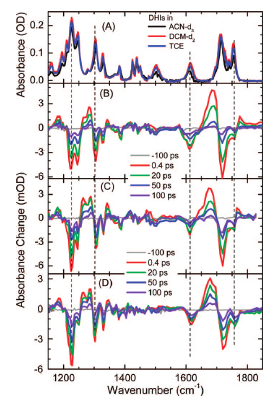-
Real-Time Observation of the Formation of Excited Radical Ions in Bimolecular Photoinduced Charge Separation: Absence of the Marcus Inverted Region Explained
M. Koch, A. Rosspeintner, K. Adamczyk, B. Lang, J. Dreyer, E.T.J. Nibbering and E. Vauthey
Journal of the American Chemical Society, 135 (26) (2013), p9843-9848


DOI:10.1021/ja403481v | unige:28966 | Abstract | Article HTML | Article PDF

Unambiguous evidence for the formation of excited ions upon ultrafast bimolecular photoinduced charge separation is found using a combination of femtosecond time-resolved fluorescence up-conversion, infrared and visible transient absorption spectroscopy. The reaction pathways are tracked by monitoring the vibrational energy redistribution in the product after charge separation and subsequent charge recombination. For moderately exergonic reactions, both donor and acceptor are found to be vibrationally hot, pointing to an even redistribution of the energy dissipated upon charge separation and recombination in both reaction partners. For highly exergonic reactions, the donor is very hot, whereas the acceptor is mostly cold. The asymmetric energy redistribution is due to the formation of the donor cation in an electronic excited state upon charge separation, confirming one of the hypotheses for the absence of the Marcus inverted region in photoinduced bimolecular charge separation processes
